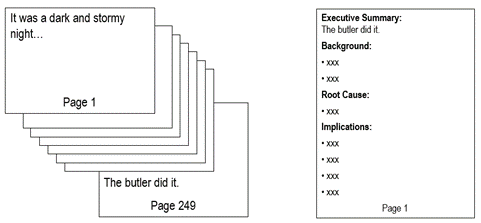Spoiler Alert: The Butler Did It
Unless you are writing about the aerodynamics of a supercar, like ProWrite did for the next-generation Acura NSX, there is no such thing as a “spoiler†in technical writing. That’s because technical writers put the most important information up front.
You can’t present facts fast enough for readers of technical material.
The typical technical audience is looking for information, and they want to find it as quickly as possible. They are going to determine within a few seconds whether your content is worth their time to read.
As a writer, the concept of putting the most important information first goes against what you were taught in English class. But life doesn’t imitate English class. ProWrite’s Efficient Writing class uses a simple yet effective infographic to explain the key difference between creative and technical writing.
Creative Writing:Technical Writing:

In creative writing, you can set the scene, build suspense, and reveal facts little-by-little to keep your reader turning pages (swiping, scrolling) right up to the end. If you are writing anything other than a fiction story—get to the point. Get directly to the point, do not pass go, and do not collect two hundred dollars (a good technical writer can make much more than that)!
In journalism school, you are taught not to bury the lead. It’s a fundamental principle of informative writing. Hit the reader in the face with the facts before delving into the details. The same goes for technical writing. It’s not that we don’t like details—we love them—but only when they support the facts. We can do without details that are superfluous, unnecessary, redundant…you get the point.
Technical reports, proposals, instructions, and any other piece of professional writing have a compelling business need to ensure the reader can easily find the most important information. From there, they will decide whether they want to read on.
Are you still reading?
Good. That means you found the information you were looking for and continued reading just for fun. Therefore, this article has served its purpose—to inform and entertain. Let’s face it—technical writing can be boring if it misses the mark. Knowing your document’s audience and purpose will guide you to create the right content every time.
So take it from us technical writers and make a point of getting to the point. Your readers will thank you for it, and even better, they will keep reading.
Posted in Blog
